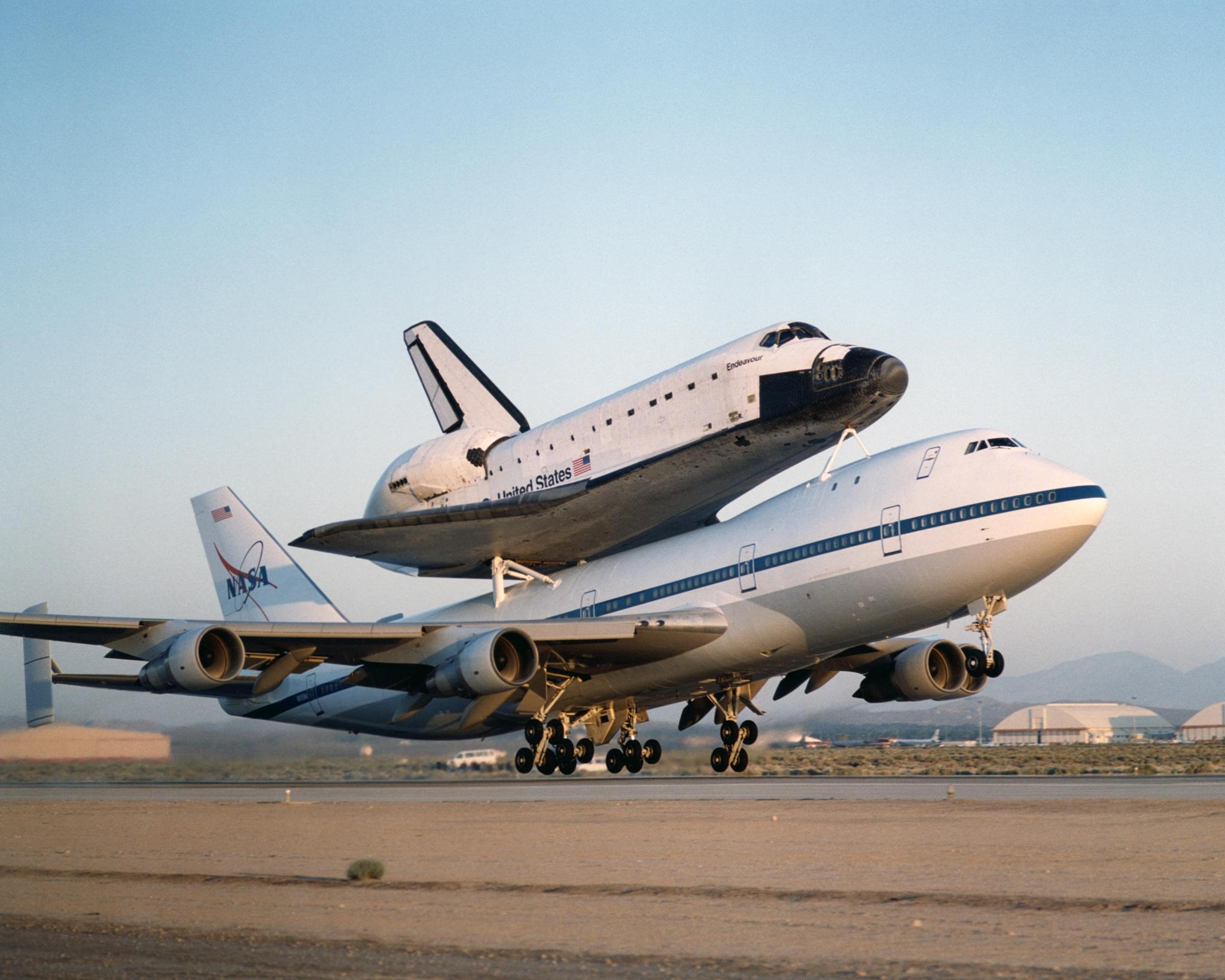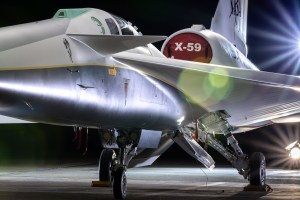NASA flew two modified Boeing 747 jetliners, originally manufactured for commercial use, as Space Shuttle Carrier Aircraft. One is a 747-123 model, while the other was designated a 747-100SR-46 model. The two aircraft were identical in performance as Shuttle Carrier Aircraft (SCA).
The 747 series of aircraft are four-engine intercontinental-range, swept-wing “jumbo jets” that entered commercial service in 1969.
The SCAs were used to ferry space shuttle orbiters from landing sites back to the launch complex at the Kennedy Space Center and also to and from other locations too distant for the orbiters to be delivered by ground transportation. The orbiters were placed atop the SCAs by Mate-Demate Devices, large gantry-like structures that hoisted the orbiters off the ground for post-flight servicing and then mated them with the SCAs for ferry flights.
Features that distinguish the two SCAs from standard 747 jetliners are:
- Three struts with associated interior structural strengthening protrude from the top of the fuselage (two aft, one forward) on which the orbiter is attached.
- Two additional vertical stabilizers, one on each end of the standard horizontal stabilizer, to enhance directional stability.
- Removal of all interior furnishings and equipment aft of the forward No. 1 doors.
- Instrumentation used by SCA flight crews and engineers to monitor orbiter electrical loads during the ferry flights and also during pre- and post-ferry flight operations.
The two SCAs were owned and under the operational control of NASA’s Johnson Space Center, Houston.
NASA 905 was the first SCA. It was obtained from American Airlines in 1974. Shortly after acceptance by NASA, the SCA flew a series of wake vortex research flights at the Dryden (now Armstrong) Flight Research Center, Edwards, Calif., in a study to seek ways of reducing turbulence produced by large aircraft. Pilots flying as much as several miles behind large aircraft have encountered wake turbulence that has caused control problems. The NASA study helped the Federal Aviation Administration modify flight procedures for commercial aircraft during airport approaches and departures.
Following the wake vortex studies, NASA 905 was modified by Boeing to its present SCA configuration and the aircraft was returned to Dryden for its role in the 1977 Space Shuttle Approach and Landing Tests (ALT). This series of eight captive and five free flights with the orbiter prototype Enterprise, in addition to ground taxi tests, validated the aircraft’s performance as an SCA, in addition to verifying the glide and landing characteristics of the orbiter configuration — paving the way for orbital flights.
A flight crew escape system, consisting of an exit tunnel extending from the flight deck to a hatch in the bottom of the fuselage, was installed during the modifications. The system also included pyrotechnics to activate the hatch release and cabin window release mechanisms. The flight crew escape system was removed from the NASA 905 following the successful completion of the ALT program.
NASA 905, a Boeing 747-123 model built in 1970, was the first and only SCA used by the space shuttle program until November 1990, when NASA 911 was delivered as an SCA. Along with ferrying Enterprise and the flight-rated shuttle orbiters between the launch and landing sites and other locations, NASA 905 also ferried Enterprise to Europe for display in England and at the Paris Air Show and the 1984 World’s Fair in New Orleans.
NASA 905 flew 70 of the 87 ferry missions during the operational phase of the shuttle program, including 46 of the 54 post-mission ferry flights from Dryden to the Kennedy Space Center. After the orbiters were retired, NASA 905 flew three ferry missions to deliver the shuttles Discovery, Enterprise, and Endeavour to museums where they are currently on display. Upon its retirement in late 2012, it had flown 11,018 flight hours over 42 years, both as a commercial jetliner and as a NASA space shuttle carrier, and had made 6,335 takeoffs and landings. It is being incorporated into a historical and educational exhibit at Space Center Houston, the Johnson Space Center’s visitor center. The exhibit is scheduled to open in 2015.
NASA 911 was the second SCA, a Boeing 747-100SR-46 version. It was built in 1973 and entered service with Japan Air Lines. The aircraft was obtained by NASA from the airline in 1989, modified by The Boeing Co. in the shuttle carrier aircraft configuration, and delivered to NASA on Nov. 20, 1990. Upon its retirement on Feb. 8, 2012, it had amassed 33,004 flight hours over its 38-year flight career, including 386 flights as a NASA shuttle carrier aircraft, 66 of which were flights with a space shuttle mounted atop the fuselage. It flew 17 of the post-shuttle-landing ferry flights from Edwards to Kennedy. NASA 911 is currently on public display at the Joe Davies Heritage Airpark in Palmdale, California, under a long-term loan agreement with NASA.
SCA Descriptions
Dimensions
- Wingspan: 195 ft. 8 in.
- Length: 231 ft. 10 in.
- Height: Top of vertical stabilizer, 63 ft. 5 in. To top of cockpit area, 32 ft. 1 in.
- Vertical tip fins on horizontal stabilizers: 20 ft. 10 in. high, 9 ft. 7 in. long.
- Weight: Basic weight, NASA 905, 318,053 lb;. NASA 911, 323,034 lb
- Maximum gross taxi weight: 713,000 lb
- Maximum gross brake release weight: 710,000 lb
- Maximum gross landing weight: 600,000 lb
Engines: Four Pratt & Whitney JT9D-7J gas turbine engines, each producing 48,600 lb of thrust.
Performance
- Airspeed limits with, and without an orbiter: 250 knots or Mach 0.6
- Altitude: Typical cruise with orbiter, 13,000-15,000 ft; typical cruise unmated, 24,000-26,000 ft. Minimum temperature at altitude 15 degrees (F) (-9 degrees C)
- Range: Typical mated, 1000 nautical miles (with reserves); maximum unmated, 5500 nautical miles
Fuel Capacity: 47,210 gallons (316,307 lb) jet fuel
Crew: Two pilots and one flight engineer; additional flight engineer when carrying shuttle.




































